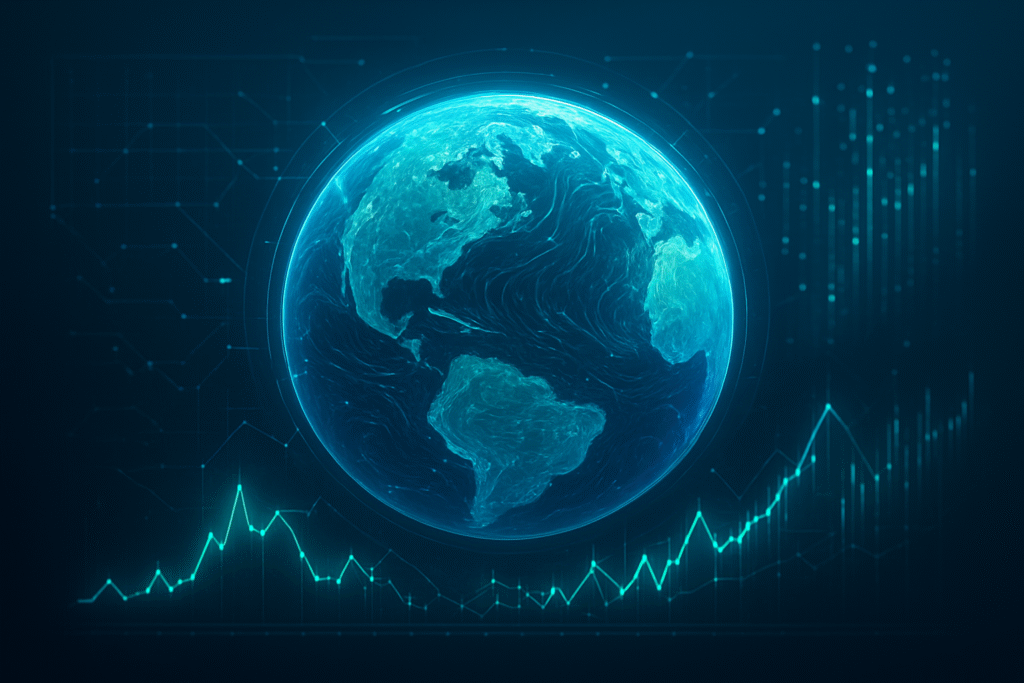
Google DeepMind (NASDAQ: GOOGL) has unveiled WeatherNext 2, its latest and most advanced AI weather model, promising to significantly enhance the speed and accuracy of global weather predictions. This groundbreaking development, building upon the successes of previous AI forecasting efforts like GraphCast and GenCast, is set to have profound and immediate implications across various industries, particularly for energy traders who rely heavily on precise weather data for strategic decision-making. The model’s ability to generate hundreds of physically realistic weather scenarios in less than a minute on a single Tensor Processing Unit (TPU) represents a substantial leap forward, offering unparalleled foresight into atmospheric conditions.
WeatherNext 2 distinguishes itself through a novel "Functional Generative Network (FGN)" approach, which strategically injects "noise" into the model's architecture to enable the generation of diverse and plausible weather outcomes. While trained on individual weather elements, it effectively learns to forecast complex, interconnected weather systems. This model generates four six-hour forecasts daily, utilizing the most recent global weather state as its input. Crucially, WeatherNext 2 demonstrates remarkable improvements in both speed and accuracy, generating forecasts eight times faster than its predecessors and surpassing them on 99.9% of variables—including temperature, wind, and humidity—across all lead times from 0 to 15 days. It offers forecasts with up to one-hour resolution and exhibits superior capability in predicting extreme weather events, having matched and even surpassed traditional supercomputer models and human-generated official forecasts for hurricane track and intensity during its first hurricane season.
The immediate significance of WeatherNext 2 is multifaceted. It provides decision-makers with a richer, more nuanced understanding of potential weather conditions, including low-probability but catastrophic events, which is critical for preparedness and response. The model is already powering weather forecasts across Google’s (NASDAQ: GOOGL) consumer applications, including Search, Maps, Gemini, and Pixel Weather, making highly accurate information readily available to the public. Furthermore, an early access program for WeatherNext 2 is available on Google Cloud’s (NASDAQ: GOOGL) Vertex AI platform, allowing enterprise developers to customize models and create bespoke forecasts. This accessibility, coupled with its integration into BigQuery and Google Earth Engine for advanced research, positions WeatherNext 2 to revolutionize planning in weather-dependent sectors such as aviation, agriculture, logistics, and disaster management. Economically, these AI models promise to reduce the financial and energy costs associated with traditional forecasting, while for the energy sector, they are poised to transform operations by providing timely and accurate data to manage demand volatility and supply uncertainty, thereby mitigating risks from severe weather events. This marks a significant "turning point" for weather forecasting, challenging the global dominance of numerical weather prediction systems and paving the way for a new era of AI-enhanced meteorological science.
Market Dynamics and the Energy Trading Revolution
The introduction of Google DeepMind's (NASDAQ: GOOGL) WeatherNext 2 is poised to trigger a significant reordering of market dynamics, particularly within the energy trading sector. Its unprecedented speed, accuracy, and granular resolution offer a powerful new lens through which energy traders can anticipate and react to the volatile interplay between weather patterns and energy markets. This AI model delivers forecasts eight times faster than its predecessors, generating hundreds of potential weather scenarios from a single input in under a minute, a critical advantage in the fast-moving world of energy commodities. With predictions offering up to one-hour resolution and surpassing previous models on 99.9% of variables over a 15-day lead time, WeatherNext 2 provides an indispensable tool for managing demand volatility and supply uncertainty.
Energy trading houses stand to benefit immensely from these advancements. The ability to predict temperature with higher accuracy directly impacts electricity demand for heating and cooling, while precise wind forecasts are crucial for anticipating renewable energy generation from wind farms. This enhanced foresight allows traders to optimize bids in day-ahead and hour-ahead markets, balance portfolios more effectively, and strategically manage positions weeks or even months in advance. Companies like BP (NYSE: BP), Shell (NYSE: SHEL), and various independent trading firms, alongside utilities and grid operators such as NextEra Energy (NYSE: NEE) and Duke Energy (NYSE: DUK), can leverage WeatherNext 2 to improve load balancing, integrate renewable sources more efficiently, and bolster grid stability. Even energy-intensive industries, including Google's (NASDAQ: GOOGL) own data centers, can optimize operations by shifting energy usage to periods of lower cost or higher renewable availability.
The competitive landscape for weather intelligence is intensifying. While Google DeepMind offers a cutting-edge solution, other players like Climavision, WindBorne Systems, Tomorrow.io, and The Weather Company (an IBM subsidiary, NYSE: IBM) are also developing advanced AI-powered forecasting solutions. WeatherNext 2's availability through Google Cloud's (NASDAQ: GOOGL) Vertex AI, BigQuery, and Earth Engine democratizes access to capabilities previously reserved for major meteorological centers. This could level the playing field for smaller firms and startups, fostering innovation and new market entrants in energy analytics. Conversely, it places significant pressure on traditional numerical weather prediction (NWP) providers to integrate AI or risk losing relevance in time-sensitive markets.
The potential for disruption is profound. WeatherNext 2 could accelerate a paradigm shift away from purely physics-based models towards hybrid or AI-first approaches. The ability to accurately forecast weather-driven supply and demand fluctuations transforms electricity from a static utility into a more dynamic, tradable commodity. This precision enables more sophisticated automated decision-making, optimizing energy storage schedules, adjusting industrial consumption for demand response, and triggering participation in energy markets. Beyond immediate trading gains, the strategic advantages include enhanced operational resilience for energy infrastructure against extreme weather, better integration of renewable energy sources to meet sustainability goals, and optimized resource management for utilities. The ripple effects extend to agriculture, aviation, supply chain logistics, and disaster management, all poised for significant advancements through more reliable weather intelligence.
Wider Significance: Reshaping the AI Landscape and Beyond
Google DeepMind's (NASDAQ: GOOGL) WeatherNext 2 represents a monumental achievement that reverberates across the broader AI landscape, signaling a profound shift in how we approach complex scientific modeling. This advanced AI model, whose announcement predates November 17, 2025, aligns perfectly with several cutting-edge AI trends: the increasing dominance of data-driven meteorology, the application of advanced machine learning and deep learning techniques, and the expanding role of generative AI in scientific discovery. Its novel Functional Generative Network (FGN) approach, capable of producing hundreds of physically realistic weather scenarios, exemplifies the power of generative AI beyond creative content, extending into critical areas like climate modeling and prediction. Furthermore, WeatherNext 2 functions as a foundational AI model for weather prediction, with Google (NASDAQ: GOOGL) actively democratizing access through its cloud platforms, fostering innovation across research and enterprise sectors.
The impacts on scientific research are transformative. WeatherNext 2 significantly reduces prediction errors, with up to 20% improvement in precipitation and temperature forecasts compared to 2023 models. Its hyper-local predictions, down to 1-kilometer grids, offer a substantial leap from previous resolutions, providing meteorologists with unprecedented detail and speed. The model's ability to generate forecasts eight times faster than its predecessors, producing hundreds of scenarios in minutes on a single TPU, contrasts sharply with the hours required by traditional supercomputers. This speed not only enables quicker research iterations but also enhances the prediction of extreme weather events, with experimental cyclone predictions already aiding weather agencies in decision-making. Experts, like Kirstine Dale from the Met Office, view AI's impact on weather prediction as a "real step change," akin to the introduction of computers in forecasting, heralding a potential paradigm shift towards machine learning-based approaches within the scientific community.
However, the advent of WeatherNext 2 also brings forth important considerations and potential concerns. A primary concern is the model's reliance on historical data for training. As global climate patterns undergo rapid and unprecedented changes, questions arise about how well these models will perform when confronted with increasingly novel weather phenomena. Ethical implications surrounding equitable access to such advanced forecasting tools are also critical, particularly for developing regions disproportionately affected by weather disasters. There are valid concerns about the potential for advanced technologies to be monopolized by tech giants and the broader reliance of AI models on public data archives. Furthermore, the need for transparency and trustworthiness in AI predictions is paramount, especially as these models inform critical decisions impacting lives and economies. While cloud-based solutions mitigate some barriers, initial integration costs can still challenge businesses, and the model has shown some limitations, such as struggling with outlier rain and snow events due to sparse observational data in its training sets.
Comparing WeatherNext 2 to previous AI milestones reveals its significant place in AI history. It is a direct evolution of Google DeepMind's (NASDAQ: GOOGL) earlier successes, GraphCast (2023) and GenCast (2024), surpassing them with an average 6.5% improvement in accuracy. This continuous advancement highlights the rapid progress in AI-driven weather modeling. Historically, weather forecasting has been dominated by computationally intensive, physics-based Numerical Weather Prediction (NWP) models. WeatherNext 2 challenges this dominance, outperforming traditional models in speed and often accuracy for medium-range forecasts. While traditional models sometimes retain an edge in forecasting extreme events, WeatherNext 2 aims to bridge this gap, leading to calls for hybrid approaches that combine the strengths of AI with the physical consistency of traditional methods. Much like Google DeepMind's AlphaFold revolutionized protein folding, WeatherNext 2 appears to be a similar foundational step in transforming climate modeling and meteorological science, solidifying AI's role as a powerful engine for scientific discovery.
Future Developments: The Horizon of AI Weather Prediction
The trajectory of AI weather models, spearheaded by innovations like Google DeepMind's (NASDAQ: GOOGL) WeatherNext 2, points towards an exciting and rapidly evolving future for meteorological forecasting. In the near term, we can expect continued enhancements in speed and resolution, with WeatherNext 2 already demonstrating an eight-fold increase in speed and up to one-hour resolution. The model's capacity for probabilistic forecasting, generating hundreds of scenarios in minutes, will be further refined to provide even more robust uncertainty quantification, particularly for complex and high-impact events like cyclones and atmospheric rivers. Its ongoing integration into Google's core products and the early access program on Google Cloud's (NASDAQ: GOOGL) Vertex AI platform signify a push towards widespread operational deployment and accessibility for businesses and researchers. The open-sourcing of predecessors like GraphCast also hints at a future where powerful AI models become more broadly available, fostering collaborative scientific discovery.
Looking further ahead, long-term developments will likely focus on deeper integration of new data sources to continuously improve WeatherNext 2's adaptability to a changing climate. This includes pushing towards even finer spatial and temporal resolutions and expanding the prediction of a wider array of complex atmospheric variables. A critical area of development involves integrating more mathematical and physics principles directly into AI architectures. While AI excels at pattern recognition, embedding physical consistency will be crucial for accurately predicting unprecedented extreme weather events. The ultimate vision includes the global democratization of high-resolution forecasting, enabling developing nations and data-sparse regions to produce their own custom, sophisticated predictions at a significantly lower computational cost.
The potential applications and emerging use cases are vast and transformative. Beyond enhancing disaster preparedness and response with earlier, more accurate warnings, AI weather models will revolutionize agriculture through localized, precise forecasts for planting, irrigation, and pest management, potentially boosting crop yields. The transportation and logistics sectors will benefit from optimized routes and safer operations, while the energy sector will leverage improved predictions for temperature, wind, and cloud cover to manage renewable energy generation and demand more efficiently. Urban planning, infrastructure development, and long-term climate analysis will also be profoundly impacted, enabling the construction of more resilient cities and better strategies for climate change mitigation. The advent of "hyper-personalized" forecasts, tailored to individual or specific industry needs, is also on the horizon.
Despite this immense promise, several challenges need to be addressed. The heavy reliance of AI models on vast amounts of high-quality historical data raises concerns about their performance when confronted with novel, unprecedented weather phenomena driven by climate change. The inherent chaotic nature of weather systems places fundamental limits on long-term predictability, and AI models, particularly those trained on historical data, may struggle with truly rare or "gray swan" extreme events. The "black box" problem, where deep learning models lack interpretability, hinders scientific understanding and bias correction. Computational resources for training and deployment remain significant, and effective integration with traditional numerical weather prediction (NWP) models, rather than outright replacement, is seen as a crucial next step. Experts anticipate a future of hybrid approaches, combining the strengths of AI with the physical consistency of NWP, with a strong focus on sub-seasonal to seasonal (S2S) forecasting and more rigorous verification testing. The ultimate goal is to develop "Hard AI" schemes that fully embrace the laws of physics, moving beyond mere pattern recognition to deeper scientific understanding and prediction, fostering a future where human experts collaborate with AI as an intelligent assistant.
A New Climate for AI-Driven Forecasting: The DeepMind Legacy
Google DeepMind's (NASDAQ: GOOGL) WeatherNext 2 marks a pivotal moment in the history of artificial intelligence and its application to one of humanity's oldest challenges: predicting the weather. This advanced AI model, building on the foundational work of GraphCast and GenCast, delivers unprecedented speed and accuracy, capable of generating hundreds of physically realistic weather scenarios in less than a minute. Its immediate significance lies in its ability to empower decision-makers across industries with a more comprehensive and timely understanding of atmospheric conditions, fundamentally altering risk assessment and operational planning. For energy traders, in particular, WeatherNext 2 offers a powerful new tool to navigate the volatile interplay between weather and energy markets, enabling more profitable and resilient strategies.
This development is a testament to the rapid advancements in data-driven meteorology, advanced machine learning, and the burgeoning field of generative AI for scientific discovery. WeatherNext 2 not only outperforms traditional numerical weather prediction (NWP) models in speed and often accuracy but also challenges the long-held dominance of physics-based approaches. Its impact extends far beyond immediate forecasts, promising to revolutionize agriculture, logistics, disaster management, and climate modeling. While the potential is immense, the journey ahead will require careful navigation of challenges such as reliance on historical data in a changing climate, ensuring equitable access, and addressing the "black box" problem of AI interpretability. The future likely lies in hybrid approaches, where AI augments and enhances traditional meteorological science, rather than replacing it entirely.
The significance of WeatherNext 2 in AI history cannot be overstated; it represents a "step change" akin to the introduction of computers in forecasting, pushing the boundaries of what's possible in complex scientific prediction. As we move forward, watch for continued innovations in AI model architectures, deeper integration of physical principles, and the expansion of these capabilities into ever more granular and long-range forecasts. The coming weeks and months will likely see increased adoption of WeatherNext 2 through Google Cloud's (NASDAQ: GOOGL) Vertex AI, further validating its enterprise utility and solidifying AI's role as an indispensable tool in our efforts to understand and adapt to the Earth's dynamic climate. The era of AI-powered weather intelligence is not just arriving; it is rapidly becoming the new standard.
This content is intended for informational purposes only and represents analysis of current AI developments.
TokenRing AI delivers enterprise-grade solutions for multi-agent AI workflow orchestration, AI-powered development tools, and seamless remote collaboration platforms.
For more information, visit https://www.tokenring.ai/.






